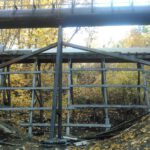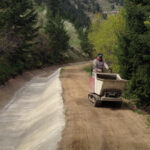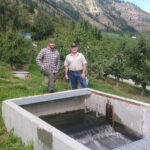In August 2017, the Jack Creek Wildfire ran rampant through the Cascade Range in Washington State, leaving thousands of acres of land destroyed and impenetrable by water. Due to the lack of absorption, the Icicle and Peshastin Irrigation Districts have been taxed with accommodating the higherthan-normal-level runoff captured in Eight Mile Dam, adding stress to the 1920s-era structure. As a result, the board declared an emergency to address looming challenges.
Irrigation Leader’s editor-in-chief, Kris Polly, spoke with Tony Jantzer, secretary-manager for Icicle and Peshastin Irrigation Districts, to learn more about the districts and the situations they are facing. In the interview, Mr. Jantzer speaks about the challenges his team faces when combating aging infrastructure in the steep terrain of the Cascade Range and the looming threat of a catastrophic dam failure at Eight Mile Lake.
 Kris Polly: Please tell our readers about your background managing irrigation districts.
Kris Polly: Please tell our readers about your background managing irrigation districts.
Tony Jantzer: I have been an irrigation district manager for a little over 22 years, and since October 2010 I have been with the Icicle and Peshastin Irrigation Districts, which operate under a joint operating agreement.Prior to joining Icicle and Peshastin Irrigation Districts, I managed the 12,600-acre Cascade Irrigation District in Ellensburg, Washington. I am a retired Air Force master sergeant, and I used to manage a wrecking yard as a kid. I received my bachelor’s degree in vocational education and three associate’s degrees in personnel management, avionic electronics, and applied sciences.
Kris Polly: Please provide an overview of the Icicle and Peshastin Irrigation Districts.
Tony Jantzer: We are different from most in that there are actually two irrigation districts that we operate. The Icicle Irrigation District is a 4,300-acre irrigation district. It has a little bit less than 40 miles of canals. Most of its canals are concrete lined. We probably have about 5 miles of pipe within this district. We are up against the Cascade Mountains near Leavenworth, Washington, so most of our canals are in steep mountainsides. The district owns four reservoirs up in the Alpine Lakes Wilderness Area and has water storage in a fifth reservoir operated by the Bureau of Reclamation. We have five water storage facilities that we get water out of for droughts and low-flow periods.
The Peshastin Irrigation district serves about 3,700 acres. It has two main diversion points on Peshastin Creek. The Peshastin took over the Tandy ditch a number of years ago, so we still operate that diversion. The Tandy ditch is a completely piped and closed system. The Peshastin is a 9- to 10-mile-long system with 80 percent concrete-lined canals, 10 percent dirt canals, and 10 percent pipe. Construction began on the Peshastin and Tandy Canals in the late 1800s and on the Icicle Canal in 1910.
The Icicle’s diversion is on Icicle Creek, and it shares ownership of the upper portion of that canal system with the Peshastin canal system. It is kind of interesting, because before the Icicle Irrigation District was formed to take over the Icicle Canal Company, water users actually had meetings with the Peshastin Irrigation District to facilitate joint ownership of the upper portion of the Icicle Canal. Still to this day, they have a joint ownership agreement.
Kris Polly: What are some of the unique challenges of moving water on mountainsides?
Tony Jantzer: Most of our canals are up on steep hillsides. It is not possible to drive a pickup to them, so we access a lot of them by motorcycle. When you are trying to replace concrete in such areas, it gets very challenging. Most has to be done by hand. We have a bunch of tracked concrete buggies, and we will haul concrete in those for a mile to the job site to pour it. That in and of itself is a challenge.
Also, because the elevations of our delivery systems are so high, we have to cut short the irrigation season to do maintenance. We get snow earlier than most and have snow later than most. We generally do not fire up our canal until the end of April, and we shut it off the last Friday of September.
Kris Polly: How are you preparing to combat aging infrastructure in your irrigation district?
Tony Jantzer: Back in the mid-1990s, most of the irrigation districts in the state of Washington completed a comprehensive water conservation plan, which took into account modernization and upkeep. We’ve done most of the things outlined in the plan, and right now we are upgrading our comprehensive water conservation plan and plan to publish it soon.
Many of us are facing similar problems associated with very old infrastructure. This past year, we replaced about 2,000 feet of concrete liner. We also put about 2,000 feet of lined and nonlined canal into pipe. Basically, we ended up with 4,300 feet of fresh canal from the past season. We still have miles and miles of old ditch that we are removing. Some of the ditch we removed this last fall had penciled-in marks dating back to 1929.
Kris Polly: This year, you faced a real emergency at Eight Mile Lake. What happened?
Tony Jantzer: Construction of the dam started in 1927. They applied for water rights for the dam in the early 1920s. They completed construction on October 10, 1929. They did the proof of appropriation document in 1932, so they had to have actually used it by that point. It has been in use since that time frame.
Modifications have been made through the years, and the dam looks quite a bit different than the original plans. In 1990, there was a very large runoff flood situation in our drainage. The runoff overtopped the Eight Mile Dam and washed away a part of the earthen portion—about a 15-foot-wide by 4- to 5-foot-deep wash around the hardened structure of the dam. The dam has been in that condition until just recently.
In 2015, during an inspection during a time of drought, we inspected the draw-out part of the lake. In doing so, we found a problem in the oldest section of the outlet pipe, which was cast in place with cement pipe. When the builders cast it in place, they used round logs to form the interior of the pipe. Once they poured cement around the logs, they could not pull them out. They were cast into the cement. Over the 90 years they have been there, they have deteriorated enough that some of them have fallen down out of the cement and are causing the pipe to plug up. We started noticing that in 2015. In 2017, we planned on removing the debris and wood, but the Jack Creek fire changed our plans.
The U.S. Forest Service closed that area because of the fire, and we were unable to get in and execute the repairs. Because of the Jack Creek fire, about 3,800 acres burned above the watershed. We are expecting, based on the burn evaluation, a much higher than normal runoff coming into the lake. Of the 3,800 acres in the watershed of the lake, over 2,000 acres burned, and over 1,000 burned severely enough to prohibit the water from entering the ground. We were also concerned that some of the trees that burned would fall into the lake and wash up against the dam, clogging that area and backing up water during a big rain event. If that were to happen, it would have caused a catastrophic failure.
Based on the scenarios, and the fact we could not draw the lake down to create a dead pool to absorb higher runoff, on March 13, 2018, the district declared an emergency to deal with the situation.
We hired an engineering firm to evaluate the conditions and devise plans to reduce the risk. We then flew an excavator to the area of the forest, ripped out a large section of the earthen portion of the dam, moved the material to the eroded portion of the dam, and hardened it with rip-rap. Now, instead of having a 13-foot-wide spillway, we have a 68-foot spillway to accommodate more runoff.
 Kris Polly: What advice do you have for other irrigation district managers facing an aging water infrastructure?
Kris Polly: What advice do you have for other irrigation district managers facing an aging water infrastructure?
Tony Jantzer: Maintain your infrastructure over time. I have watched a lot of other irrigation districts keep assessments constant, and then get backed up against it, forcing them to complete their entire canal infrastructure at one time and double their rates to pay for it. Some entities around our state have doubled assessments overnight. That is really hard on farmers.
What we have tried to do here is raise our rates a little at a time to keep a buffer for big emergencies or big projects. I have tried to increase the year-to-year maintenance to stay on top of our infrastructure. Instead of doing the entire infrastructure checklist at one time, we are doing it on an ongoing basis. I think we are making headway.
The districts have 10–12 big siphons, some of which are over $1 million each to replace. Many have been in the ground since the 1960s, and some of them are starting to have problems. Like every other district, we have infrastructure projects we are trying to pencil out to pay for upfront.
We are facing a real challenge at this point dealing with the U.S. Forest Service on our reservoirs in the wilderness area. I know many irrigation entities with canals and infrastructure within U.S. Forest Service areas that have had problems. Our problems are compounded because we are also dealing with the Wilderness Act. Our lakes and reservoirs are within the Alpine Lakes Wilderness Areas, so we get a lot of scrutiny from environmental groups. Nevertheless, we are working with our congressional delegation and with U.S. Forest Service leadership to find a resolution that will benefit all parties involved.



